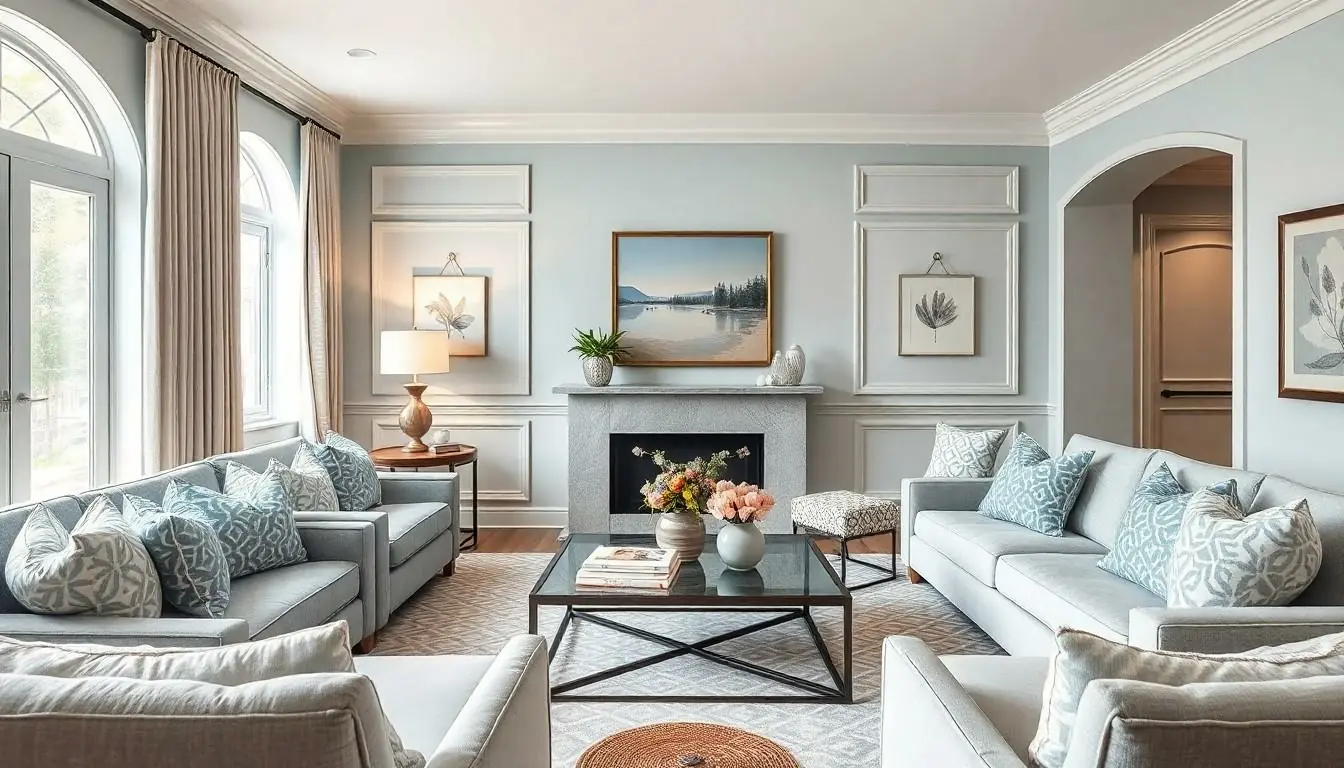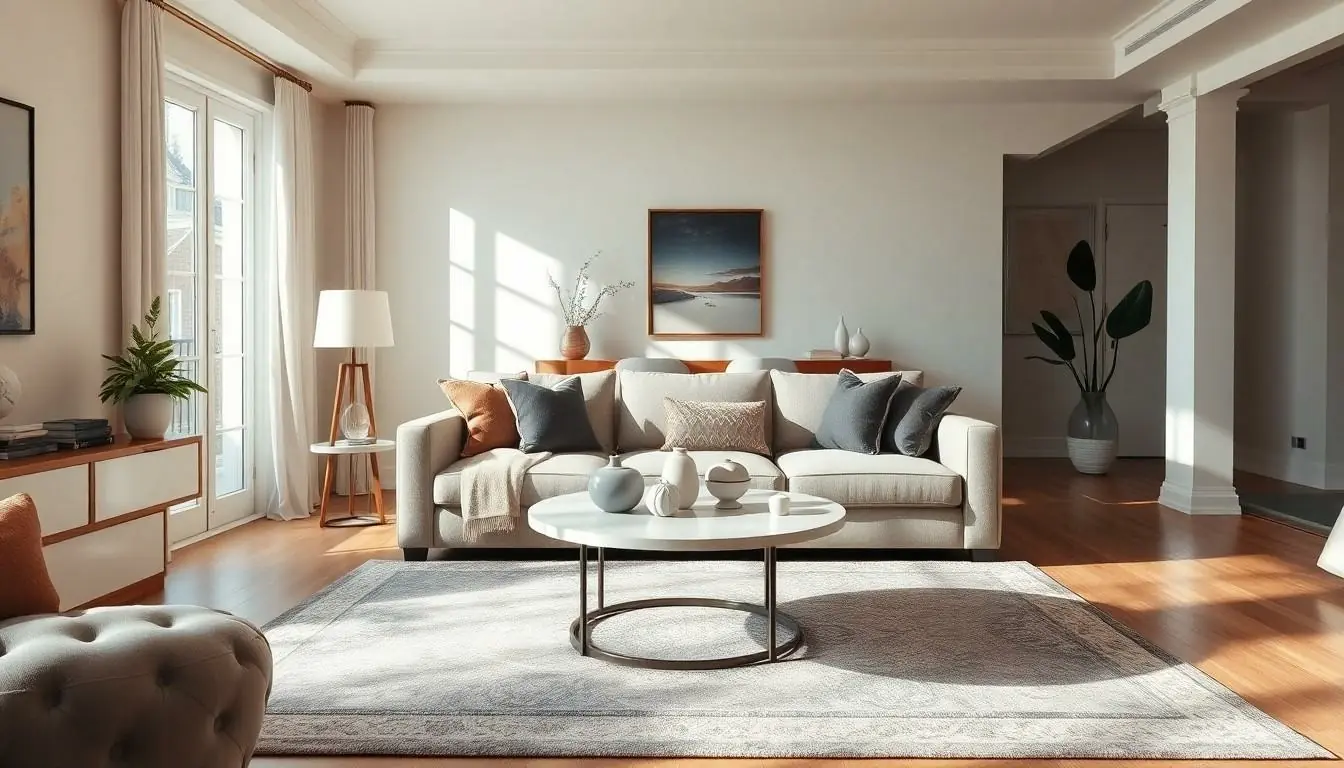In the world of interior design, unity is the secret sauce that turns a chaotic space into a harmonious retreat. Imagine walking into a room where everything feels effortlessly connected, like a well-rehearsed dance troupe. That’s the magic of unity—it ties colors, textures, and styles together, creating a vibe that says, “Welcome home!” instead of “What on earth were they thinking?”
But don’t be fooled; achieving this balance isn’t just about slapping a matching throw pillow on every chair. It’s an art form that requires finesse, creativity, and maybe a dash of humor. After all, who wouldn’t want their living room to feel like a cozy hug rather than a game of hide-and-seek with mismatched decor? Let’s dive into the principles of unity in interior design and discover how to transform any space into a cohesive masterpiece that even your most discerning friends will envy.
Table of Contents
ToggleUnderstanding Unity In Interior Design
Unity in interior design serves as a fundamental aspect that connects various elements within a space. This concept emphasizes the importance of creating harmony through colors, textures, and styles.
Definition Of Unity
Unity refers to the cohesive relationship among different design components. It encompasses the blend of colors, patterns, and furniture styles to form an overall sense of balance. When achieving unity, designers focus on creating visual ties that link diverse elements, offering a seamless flow within the room. Cohesion often emerges from the thoughtful selection of similar hues or complementary materials, ensuring that each piece contributes to the overall aesthetic experience.
Importance Of Unity In Design
Unity plays a crucial role in making a space feel complete and welcoming. Establishing a sense of togetherness among design elements enhances the visual appeal and instills a feeling of comfort. A unified space avoids overwhelming contrasts that can distract the eye and disrupt the atmosphere. Designers rely on principles of unity to guide clients in choosing furnishings that resonate with the desired mood. Furthermore, a well-executed unity embeds a professional touch, showcasing skill and attention to detail. Ultimately, harmony in design cultivates an inviting environment that pleases both the occupants and visitors.
Principles Of Unity

Unity in interior design involves connecting various elements to create a harmonious environment. Understanding and applying its principles transforms spaces into inviting havens.
Types Of Unity
Unity manifests in different forms, each contributing to a cohesive design. Color unity revolves around using a consistent color palette. Repeating patterns among textiles and accessories demonstrates pattern unity. Proximity unity occurs when furniture pieces are placed close together to create groupings. Style unity focuses on a common theme or aesthetic, while structural unity accentuates architectural elements that harmonize a space. These types work together to enhance the overall visual experience.
Techniques To Achieve Unity
Achieving unity requires strategic techniques to connect elements within a space. First, select a color scheme that ties the room together. For instance, incorporating complementary colors creates balance. Next, use repetition through materials and patterns to reinforce cohesion. Furniture arrangement plays a crucial role; grouping items encourages visual relationships. Scale consistency also enhances unity, ensuring that furniture and decor maintain similar proportions. Applying these techniques builds a unified atmosphere, elevating the overall design.
Examples Of Unity In Interior Design
Unity in interior design manifests in various settings, enhancing both residential and commercial spaces through thoughtful connections among elements.
Residential Spaces
Residential spaces benefit from cohesive color palettes and consistent materials. A living room may showcase a unified theme through soft, neutral tones combined with varying textures like plush throws or smooth wooden furniture. Area rugs typically anchor spaces, tying together seating arrangements while reinforcing style unity. Accent pieces, such as coordinating art and decor, add visual interest without creating chaos. Thoughtful placement of furniture promotes proximity unity, ensuring that rooms feel spacious yet inviting. This careful integration ultimately establishes an inviting haven that resonates with warmth.
Commercial Spaces
In commercial spaces, unity fosters a professional atmosphere. Office environments often utilize consistent branding through color schemes and furniture styles. Shared zones, such as break areas, frequently employ similar textures and finishes, enhancing visual continuity. Effective use of open layouts further promotes a sense of balance, allowing seamless interactions among employees. Wall art displaying brand values or themes ties together both aesthetic and functional aspects, reinforcing identity. Specific lighting choices can enhance both mood and focus, creating a unified experience for visitors and staff alike.
Benefits Of Achieving Unity
Achieving unity in interior design offers numerous advantages, enhancing both aesthetics and functionality within a space.
Aesthetic Appeal
Aesthetic appeal greatly improves with unity in design. Cohesive color schemes create visual harmony that draws the eye, while consistent materials unify the look. Diverse design elements, when centered around a common theme, foster balance, making the space feel complete. Rooms exuding unity evoke comfort and elegance, inviting occupants to relax and appreciate the environment. Each piece complements others, allowing the overall design to shine without distracting clashes. Designers often find that unity transforms spaces, producing a polished, professional appearance. By creating a stunning backdrop, unity stands out as a crucial factor in successful interior design.
Enhanced Functionality
Enhanced functionality results from achieving unity in interior spaces. Flow and organization arise when design elements are thoughtfully coordinated. Cohesion among furniture layouts promotes ease of movement, allowing occupants to navigate without obstruction. Additionally, a unified style aids in identifying purpose, making areas more intuitive and efficient. When materials and colors align, users can quickly grasp the character of each zone, enhancing usability for everyone involved. Clarity is achieved through design continuity, minimizing distractions while maximizing effectiveness. Unity not only elevates aesthetics but also fulfills practical needs in both residential and commercial environments.
Challenges In Maintaining Unity
Maintaining unity in interior design presents various challenges that can dilute the cohesive atmosphere intended for a space.
Common Pitfalls
Poor coordination of colors can lead to discordant environments. Neglecting the importance of scale often results in mismatched furniture and accessories, disrupting harmony. Inconsistent themes across different rooms break the visual flow needed for unity. Additionally, a lack of thoughtful arrangement creates awkward spaces that feel disjointed. Relying solely on trendy elements without considering overall cohesion may result in a chaotic appearance. Familiarity with these common pitfalls helps designers avoid mistakes that compromise unity.
Solutions To Overcome Challenges
Establishing a consistent color palette sets a strong foundation for unity. Incorporating repetition in patterns and materials reinforces visual connections between elements. Thoughtful furniture arrangement enhances relationships, creating a seamless flow throughout the space. Maintaining scale consistency ensures that all components coexist in harmony. Design professionals might also consider using focal points to unify distinct areas, guiding the eye throughout the environment. Addressing these solutions fosters a cohesive and inviting atmosphere, enhancing overall design effectiveness.
Achieving unity in interior design is essential for creating spaces that feel cohesive and inviting. By thoughtfully connecting colors, textures, and styles, designers can transform any environment into a harmonious haven. This balance not only enhances aesthetic appeal but also improves functionality, making spaces more intuitive and efficient.
Overcoming challenges like mismatched elements requires careful planning and a keen eye for detail. With the right strategies in place, unity can elevate a design, ensuring it resonates with both occupants and visitors. Ultimately, embracing the principles of unity leads to beautifully curated spaces that reflect professionalism and creativity.




